Updated on: Dec 3, 2023
This article has been updated to reflect the accounting software re-brand from Simplifi to Joy Pilot.
The vast majority of our accounting clients use Joy Pilot for their online cloud accounting software, where they can complete all the usual tasks such as creating invoices, expenses, and checking their business profit and loss. Joy Pilot does however have a host of other features much more specific to the requirements of our contractor client base.
Also, while this is a review of Joy Pilot vs Xero it is also important to point out here that Joy Pilot is a cloud accounting software that was MADE by us. Our clients love the ease of use, but it goes without saying that we’re a little biased when it comes to Joy Pilot, plus we provide it for free to all our accounting clients. However, as an accounting firm we also have significant experience with Xero. This isn’t a beat-up piece where we extoll the virtues of Joy Pilot over Xero, but in this Joy Pilot vs Xero cloud accounting software post we will attempt a fair-sided review of the main features of cloud accounting software that our clients use.
Background
Xero. Founded in 2006, Xero is a major cloud accounting software product that has 3.5 million subscribers and is a leader in cloud accounting across New Zealand, Australia and the United Kingdom. Xero is a publicly owned company with over 4,500 employees and is mainly owned by Australian based institutional funds. It has offices in Australia, New Zealand, United Kingdom, United States, Canada, Singapore, Hong Kong, and South Africa.
Joy Pilot. Founded as its own entity in 2017 but has operated its own cloud accounting software since 2005. Joy Pilot is 100% owned by its founders Greg Hanton and Helen McMurtrie who currently live in New Zealand. Our No Worries Accounting and Capital City Accountancy clients enjoyed exclusive use until 2021, when Joy Pilot was launched as a standalone cloud accounting software product for freelancers and contractors. Joy Pilot is based in Auckland, NZ, and all staff/contractors work remotely.
Invoicing
A key element to any cloud accounting software package is how to create invoices. For our clients Invoices need to be easy to prepare, easy to send to their clients, and with a simple reporting structure. Here we will cover the main features that our clients typically need and use.
Xero. To create a new Invoice, click on Business -> Invoices and then the `New Invoice` button to create a new invoice. Alternatively, you can select the ‘+’ icon in the menu header and select ‘Invoice’ to create a new invoice. Complete the usual invoice entries including date, currency, invoice line items, and VAT rate. Once the invoice is completed, click ‘Approve’. Once the Invoice has been approved you can download a PDF of the invoice or email it directly from Xero to your client.
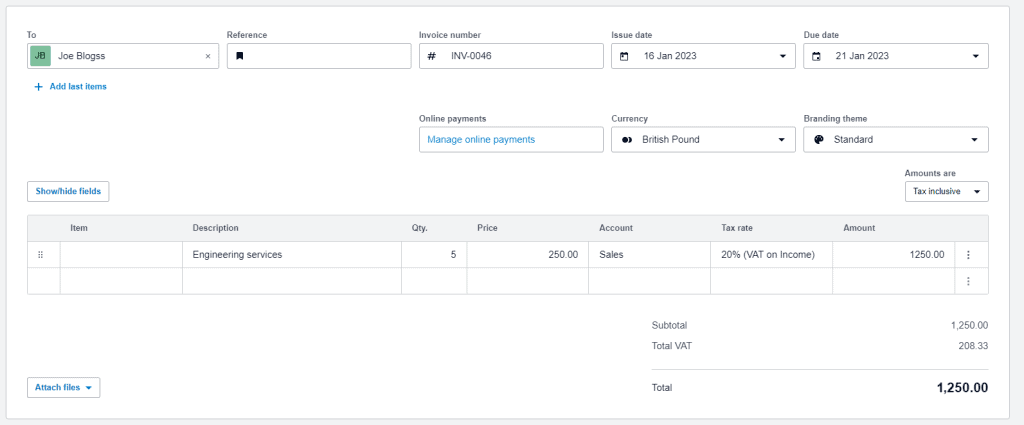
Joy Pilot. To create a new Invoice, click on Business -> Sales Invoices and then the ‘Create New’ button to create a new invoice. Alternatively click the ‘Create New’ button next to the Invoices section on the Dashboard page. Complete the usual invoice entries including date, currency, work period, invoice line items, and VAT rate. At the bottom of the Invoice page select if you would like to also email it to your client once it has been saved. Once the invoice is completed, click ‘Save as final’, and from next screen you can download the finished invoice as a PDF.
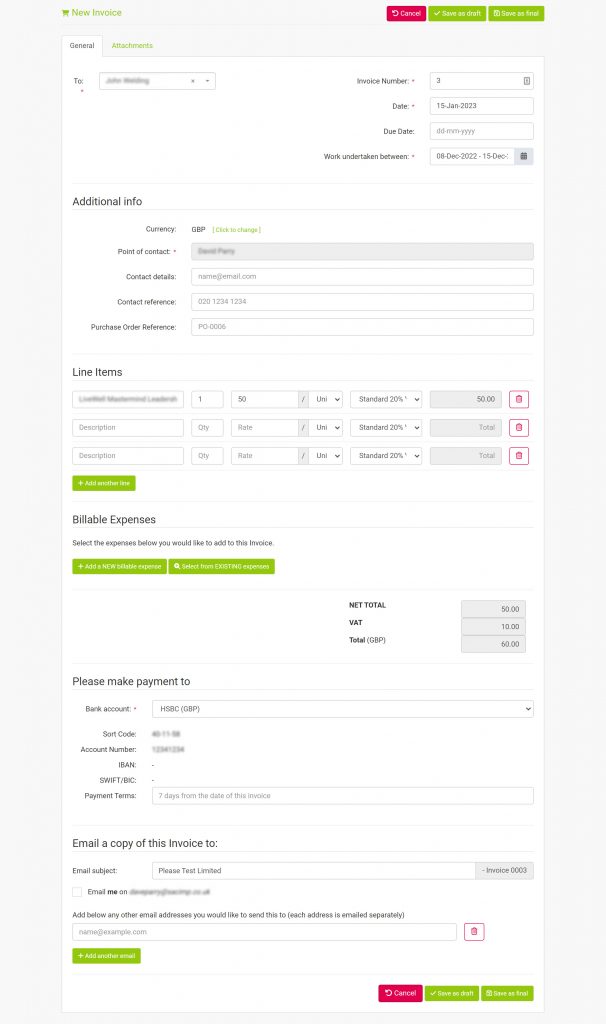
Summary of Invoicing
Xero has a few additional invoicing features such as accepting online payments (eg Stripe), selecting the specific accounts code for the Invoice income to appear in, and the ‘Approval status’ of the Invoice. However, these features are typically not used by our accounting clients that use Xero, and as a result do not appear in Joy Pilot.
One useful feature of Joy Pilot is that users can select the period of work that each Invoice relates to. For our users who bill their client every week or month, it’s useful to see the period that each Invoice covers so that at a glance they can check that their Invoices are all up to date.
Joy Pilot also allows the user to mark the Invoice as ‘Paid’ before it has been matched to a bank transaction. This shortcut helps the user easily keep track of their Invoice payments without having to complete a bank reconciliation. We call this a “soft reconcile” and it does not actually update any P&L figures, it just shows the user that the Invoice has been paid. When the bank reconciliation is completed, these “soft reconciled” invoices become fully reconciled to a banking transaction.
Both Xero and Joy Pilot offer multi-currency support, adding the company logo to Invoices, being able to add attachments to the Invoice, and send invoices by email.
Expenses
The most commonly used function of any cloud accounting software is adding Expenses and the following information is how each online accounting software product handles expenses specifically for the needs of the contractor / freelancer. Typical expenses for this client base are travel & subsistence, mobile phone costs, subscriptions, contractor insurance, accounting fees, training, and office costs. Expenses for sole traders is covered in more detail here.
Bear with me on this one because it’s a real bugbear of mine how Xero handles expenses. In this test, I think Joy Pilot comes out as the clear winner, but that’s just me ????
Xero. To create a new expense, click on Business -> Bills to Pay and then the `New Bill` button to create a new expense, or select the ‘+’ icon in the menu header and select ‘Bill’ to create a new expense. Here add the usual Expense entries such as date, description, account, and VAT rate. Once the ‘Approve’ button is clicked the Expense is saved and see the ‘Approved’ version of the expense on screen. The Bill shows as unpaid until it has been reconciled with a bank transaction.
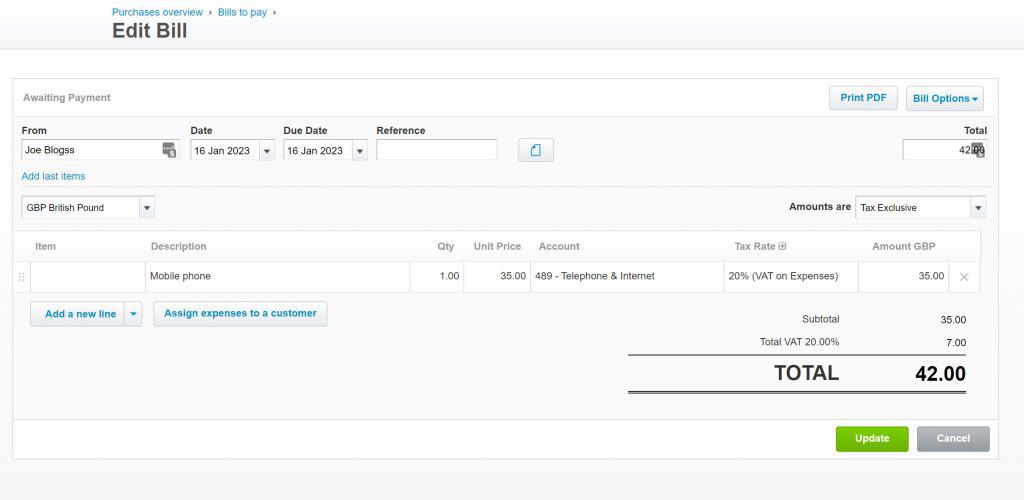
Joy Pilot. To create a new expense, click on Business -> Expenses and add a new Expense to the top part of the Expenses page. Here add the usual Expense entries such as date, who paid (business or personal), description, account, and VAT rate. Once the ‘Save Expense’ button is clicked the Expense is saved, and you can see it is added to the list of Expenses shown further down the page. If the Expense has been recorded as paid from a company bank account, it will show as unpaid until it has been reconciled.
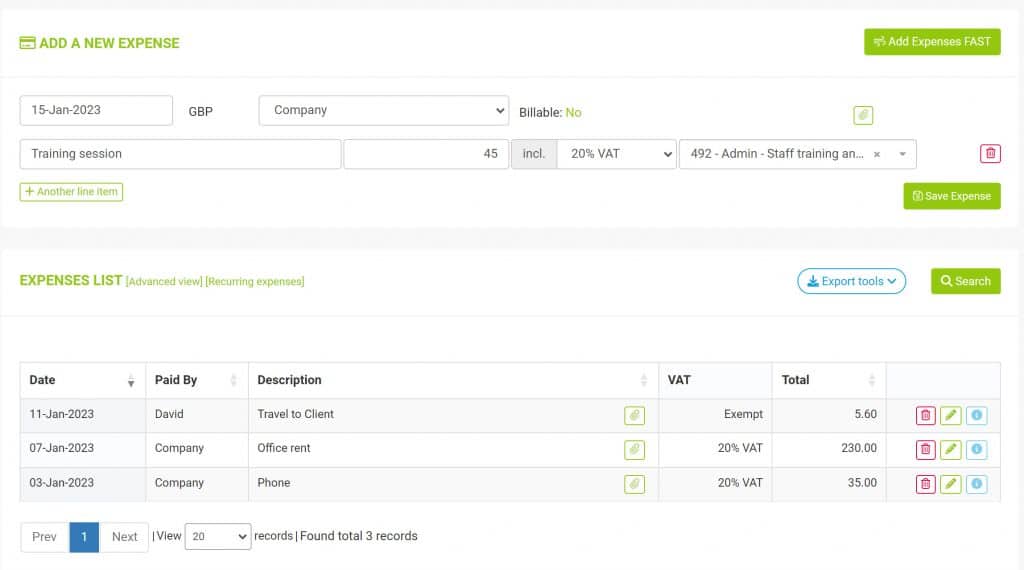
Summary of Expenses
So far both products appear to treat Expenses the same, but there are two main issues.
The first is that Xero makes is very hard to record an Expense as personally paid. Some of our accounting clients do not have a card for their business bank account, and others will sometimes accidentally leave their card at home. In these circumstances they may use a personal debit/credit card to pay for business Expenses, and this is where a solution to handle personally paid Expenses becomes extremely useful.
In Xero you cannot go to the Bills page and add a new personally paid expense. Instead, it’s a convoluted process that is best suited for larger organisations that have employees who submit Expenses that then need to be `Approved` by a senior manager. This makes the recording and reimbursement of personally paid Expenses extremely hard in Xero and this approval function is not something our accounting clients require. In fact, for me, it would be a deal breaker because Expenses is the most heavily used accounting function for our freelancer/contractor clients.
Joy Pilot handles this much better. When adding an Expense to Joy Pilot, you can choose whether the Expense was paid for from a company bank account, or from a user’s personal bank account. It immediately resolves the issue that Xero has, plus Joy Pilot will track your total personally paid Expenses so you can see how much you need to reimburse yourself.
The other issue occurs when reconciling Expenses directly from the bank feed in Xero. If you have not already added a Bill to Xero, and instead reconcile the bank transaction directly from the Xero reconcile page, a Bill is not created for you. The bank transaction is correctly added to the P&L, but it does not exist as a Bill anywhere in Xero. You could reconcile 20 bill payments through Xero, and not have a single Bill showing on your Business -> Bills to Pay page.
In Joy Pilot, when reconciling bank transactions from the Bank Reconcile page, if the transaction relates to an Expense, the bank transaction is correctly added to the P&L and a new Expense is also automatically created. So after reconciling 20 bill payments through Joy Pilot, you would see 20 new Expenses showing on your Business -> Expenses page. As well, if you have already added the Expenses beforehand, our Bank Reconcile page will match these to the banking transactions you are reconciling, which avoids any Expense duplication.
Handling Taxes
Our accounting clients love to know where they stand in terms of taxes due. Because the vast majority of our clients are freelancers / contractors, their corporation tax, VAT, and personal taxes are all highly relevant because it is essentially a summary of the tax “they” owe. We know that company tax and VAT are tax liabilities for the company, and that personal tax liability falls to the individual, but for our typical client, when they want to know how much tax “they” owe, they are referring to both company tax and personal tax.
Xero. On any given day, how much VAT do you owe? Include VAT on all transactions to date, along with VAT payments already made. There does not appear to be an easy way to extract this information from Xero. You could navigate to Reports -> VAT Returns but you will only be able to see the VAT calculations for VAT periods that have already ended. There does not appear to be any reports available showing VAT calculations for the current period. Corporation tax is not calculated by Xero. Personal taxes are not calculated by Xero.
Joy Pilot. On any given day, how much VAT do you owe? This is reported on your Dashboard page and includes all accounting transactions added to date. As a core tax liability for our clients, we ensure this information is easily available. Our Dashboard page also reports any accrued corporation tax liability to date.

One of the things our users love is the Personal Tax reporting page. Here we take salary, dividends, and any ‘other income’, and calculate the Personal tax that will be due for the user at the end of the personal tax year.
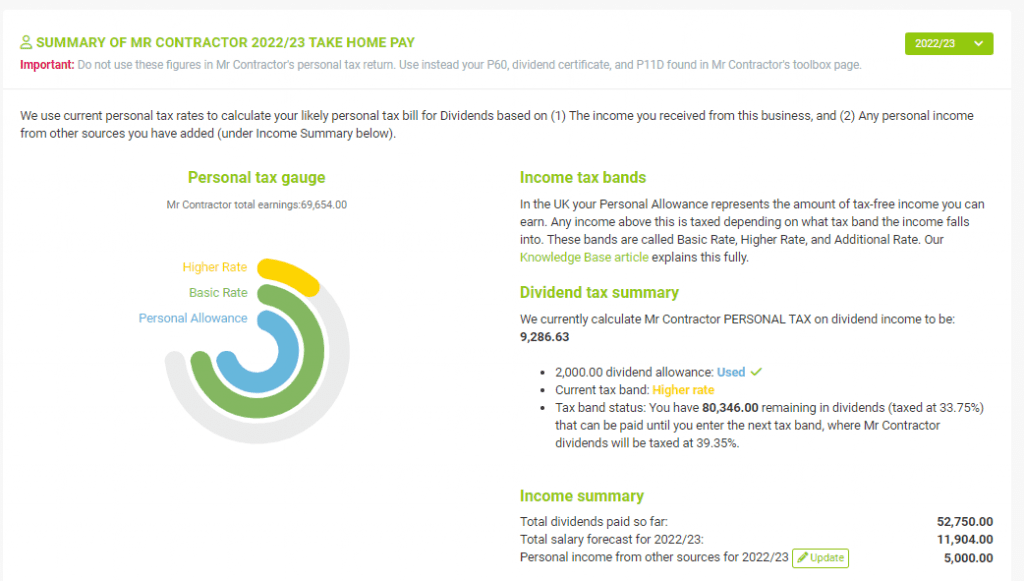
Summary of Taxes
Reporting of taxes is an unfair comparison when looking at Xero versus Joy Pilot. Xero is not only built for small businesses, but also medium sized firms that have requirements far beyond what our contractor clients need. Our Joy Pilotaccounting product is specifically built to help give our users a complete overview of the taxes “they” owe which is something that experience has shown us they like to track closely.
Whether it is company taxes or personal taxes, Joy Pilot shows the full picture, and gives our users a complete understanding of the taxes that are owed. It’s important to note here that Joy Pilot does not prepare and file company or personal tax returns, but it does do a very good job at calculating the taxes that are due. In nearly all cases the calculation of company tax and personal tax is accurate to within 1% which is absolutely ideal for our users.
Bank Feeds
A core aspect of any bookkeeping software is the ability to import bank feeds directly. This function vastly speeds up bookkeeping and helps ensure the reliability of the underlying accounting transactions in the business bank accounts.
Xero. Bank transactions into Xero are supplied by Tink. This is a solid bank feed provider, and the quality of incoming data is absolutely fine.
Joy Pilot. Bank transactions into Joy Pilot are supplied by Salt Edge. This is a solid bank feed provider, and the quality of incoming data is absolutely fine.
Summary of Bank Feeds
Pretty much same same here. The only area where Joy Pilot has a slight advantage is that along with bank statements it also collects (a) the bank account closing balances every day and (b) the user can see a full list of banking transactions directly from Salt Edge. This information is useful where a bank transaction may have accidentally been deleted, or where bank transactions exist that pre-date the imported transactions.
Pricing
Last but not least let’s cover off the pricing for each of these bookkeeping software products. All costs below exclude VAT.
Xero. There are four different packages on offer, and the most suitable one depends on your circumstances. If you need to use multiple currencies, then straight off the bat your subscription will cost you £36 per month. And if you need Payroll, you can add £5 per month to each package after the initial 3-month period has expired. To be fair, for most of our existing clients the Starter or Standard package will fit. Assuming the Payroll module is needed (nearly all of our accounting clients use Payroll), the cost will be either £19 or £33 per month incl GST.
Joy Pilot. Because Joy Pilot targets a niche community of freelancers, and contractors, the pricing schedule is simple. The fully featured Joy Pilot product is £10.50 per month plus the Payroll add-on is £2.70 per month, giving an all-in cost of £13.20 per month.
Joy Pilot also offers a Deep Freeze option, which is unique in its industry, and again reflects the demands of our users. What if you take 6 months off contracting, or you work overseas for a year? Will you keep paying the full monthly fee to your accounting software provider even through you are pretty much not even using it? With Joy Pilot, just downgrade your subscription to our Deep Freeze package. You can still access all your data, and reconcile the odd transaction here and there, but its all for the vastly reduced price of £2.70 per month. Once you are back trading again, just upgrade back to the standard package.
For all our No Worries accounting clients the pricing does not matter – its provided free of charge as part of our monthly accounting service.
Conclusion
I have touched on five main aspects show how Joy Pilot compares to Xero. We are all big fans of Joy Pilot because it has been our passion project since 2003, and I have tried to compare the two online accounting software products with as little bias as possible.
Naturally it’s a tricky thing to do when we own one of the software companies but I hope I have been able to provide some insight into how the two products compare when used by the typical contractor client that we have here at No Worries Accounting.
Software providers like Xero and Sage Business Cloud cater to much wider audience than we do including small business owners, and I have not covered other items such as receipt scanning, simplified payroll, financial reporting, or unlimited users which Joy Pilot also provides.
The nice thing about owning Joy Pilot is that we are able to continually update it adding new features and because we are a small firm, we can make these changes incredibly fast. We are looking forward to seeing what 2023 will bring.

